Adherence to wearing footwear for diabetic footproblems in Sawangdandin district
Keywords:
diabetic footwear, diabetic foot ulcer, Sawangdandin districtAbstract
Pressure from ill-fitting shoes is an important factor contributing to foot ulcers in diabetic patients. Regularly wearing a diabetic footwear is an effective way to prevent diabetic foot ulcers. Sawangdaendin Hospital has provided diabetes foot care services, but did not know how the patients use the footwear given by the hospital. This descriptive study aimed to study the adherence of diabetic footwear and to investigate patients’ opinion and satisfaction on diabetic footwear. The data was collected from 140 patients who have received diabetic footwear from 1 January 2015 to 31 December 2017. The questionnaires were sent to medical staff who worked in health promoting hospitals. Our staff interviewed the patients and sent the collected data back to Sawangdaendin Hospital via Google form or post.
This study found 4 of 88 respondents refused to wear diabetic shoes (4.5%). The average duration of diabetic footwear use was 3.55 hours per day. The most activity of wearing diabetic shoes was hospital visiting (68.2%). The reasons for not to wear diabetic shoes were due to damaged shoes (37.7%), difficult to put on and off shoes (22.6%), concerning of the shoes being old (20.8%) and not suitable for daily living (20.8%). Patients rated score of overall satisfaction for 7.78, general appearance for 7.42, and comfort in walking for 8.10.
This study concluded that although most patients had positive opinion toward diabetic footwear, the adherence to wear diabetic footwear was quite low. The most common cause of not wearing diabetic shoes were due to damaged shoes. Therefore, the healthcare providers should provide a regular follow-up after patients received diabetic shoes to check the shoes and to emphasize the importance of wearing diabetic footwear to each patient.
References
2. Aekplakorn W, Stolk RP, Neal B,Suriyawongpaisal P, Chongsuvivatwong V, Cheepudomwit S, et al. The prevalence and management of diabetes in Thai adults: the international collaborative study of cardiovascular disease in Asia. Diabetes care 2003;26(10):2758-63.
3. Papatheodorou K, Papanas N, Banach M, Papazoglou D, Edmonds M. Complications of diabetes 2016. J Diabetes Res 2016;2016: 6989453.
4. Rebolledo F, Teran Soto J, Escobedo J. The pathogenesis of the diabetic foot ulcer: prevention and management. In: Dinh T, editors. Global perspective on diabetic foot ulcerations [Internet]. Shanghai: InTech; 2011 [cited 2018 Feb 3]. Available from: https://www.intechopen.com/books/globalperspective-on-diabetic-footulcerations/the-pathogenesis-of-the-diabeticfoot-ulcer-prevention-andmanagement
5. Ibrahim A, Jude E, Langton K, Jesus FRM-D, Harkless LB, HananGawish, et al. IDF clinical practice recommendation on the diabetic foot: a guide for health care professionals [Internet]. Brussels: International Diabetes Federation; 2017[cited 2018 Feb 3]. Available from: https://www.idf.org/e-library/guidelines/119-idf-clinical-practice-recommendations-ondiabetic-foot-2017.html
6. Price P. The diabetic foot: quality of life. Clin Infect Dis 2004; 39 (Suppl 2): S129-31.
7. Mazlina M, Shamsul AS, Jeffery FA. Health-related quality of life in patients with diabetic foot problems in Malaysia. Med J Malaysia 2011;66(3):234-8.
8. Zhang P, Lu J, Jing Y, Tang S, Zhu D, Bi Y. Global epidemiology of diabetic foot ulceration: a systematic review and metaanalysis (dagger). Ann Med 2017;49(2):106-16.
9. Lopez-de-Andres A, Martinez-Huedo MA, Carrasco-Garrido P, Hernandez-Barrera V, Gil-de-Miguel A, Jimenez-Garcia R. Trends in lower-extremity amputations in people with and without diabetes in Spain, 2001-2008. Diabetes care 2011;34(7):1570-6.
10. ResnickHE, Valsania P, Phillips CL. Diabetes mellitus and nontraumatic lower extremity amputation in black and white Americans: the national health and nutrition examination survey epidemiologic follow-up study, 1971-1992. Arch Intern Med 1999;159 (20):2470-5.
11. กรมการแพทย์.สถาบันวิจัยและประเมินเทคโนโลยีทางการแพทย์.แนวทางเวชปฏิบัติการป้องกันและดูแลรักษาผู้ป่วยเบาหวานที่มีภาวะแทรกซ้อนที่เท้า.กรุงเทพฯ: กรมการแพทย์; 2556.
12. Margolis DJ, Malay DS, HoffstadOJ, Leonard CE, MaCurdy T, Nava KLd, et al.Incidence of diabetic foot ulcer and lowerextremity amputation among Medicare beneficiaries, 2006 to 2008: Data Points Publication Series [Internet]. 2011. [cited 2018 Feb 3].Available from: https://www.ncbi.nlm.nih.gov/
books/NBK65149/
13. Stockl K, Vanderplas A, Tafesse E, Chang E. Costs of lower-extremity ulcers among patients with diabetes. Diabetes care 2004;27(9):2129-34.
14. Deerochanawong C, Ferrario A. Diabetes management in Thailand: a literature review of the burden, costs, and outcomes. Global Health 2013;9(1):11.
15. Nitiyanant W, Chetthakul T, SangA-kadP, Therakiatkumjorn C, Kunsuikmengrai K, Yeo JP. A survey study on diabetes management and complication status in primary care setting in Thailand. J Med Assoc Thai 2007;90(1):65-71.
16. Patout CA, Jr., Birke JA, Horswell R, Williams D, Cerise FP. Effectiveness of a comprehensive diabetes lower-extremity amputation prevention program in a predominantly lowincome African-American population. Diabetes Care 2000;23(9):1339-42
17. Bus SA, Armstrong DG, van Deursen RW, Lewis JE, Caravaggi CF, Cavanagh PR. IWGDF guidance on footwear and offloading interventions to prevent and heal foot ulcers in patients with diabetes. Diabetes Metab Res Rev 2016;32(Suppl 1):S25–36.
18. Bus SA, van Deursen RW, Armstrong DG, Lewis JE, Caravaggi CF, Cavanagh PR. Footwear and offloading interventions to prevent and heal foot ulcers and reduce plantar pressure in patients with diabetes: a systematic review. Diabetes Metab Res Rev 2015;32 (Suppl 1):S99–118.
19. Waaijman R, Keukenkamp R, de Haart M, Polomski WP, Nollet F, Bus SA. Adherence to wearing prescription custom-made footwear in patients with diabetes at high risk for plantar foot ulceration. Diabetes care 2013;36(6):1613-8.
20. Knowles EA, Boulton AJ. Do people with diabetes wear their prescribed footwear?. Diabet Med 1996;13(12):1064-8.
21. Jarl G, Lundqvist LO. Adherence to wearing therapeutic shoes among people with diabetes: a systematic review and reflections. Patient Prefer Adherence 2016;10:1521-8.
22. Wayne WD. Biostatistics: a foundation of analysis in the health sciences. 6th ed. New York: John Wiley&Sons; 1995.
23. Crews RT, Shen BJ, Campbell L, Lamont PJ, Boulton AJ, Peyrot M, et al. Role and determinants of adherence to off-loading in diabetic foot ulcer healing: a prospective investigation. Diabetes care 2016;39(8):1371-7.
24. Jayasinghe SA, Atukorala I, Gunethilleke B, Siriwardena V, Herath SC, De Abrew K. Is walking barefoot a risk factor for diabetic foot disease in developing countries?. Rural Remote Health 2007;7(2):692.
25. Chantelau E, Haage P. An audit of cushioned diabetic footwear: relation to patient compliance. Diabet Med 1994;11(1):114-6.
Downloads
Published
How to Cite
Issue
Section
License
การละเมิดลิขสิทธิ์ถือเป็นความรับผิดชอบของผู้ส่งบทความโดยตรง
ผลงานที่ได้รับการตีพิมพ์ถือเป็นลิขสิทธิ์ของผู้นิพนธ์ ขอสงวนสิทธิ์มิให้นำเนื้อหา ทัศนะ หรือข้อคิดเห็นใด ๆ ของบทความในวารสารไปเผยแพร่ทางการค้าก่อนได้รับอนุญาตจากกองบรรณาธิการ อย่างเป็นลายลักษณ์อักษร



